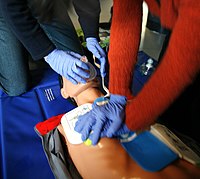
Patterns in continuous pulse oximetry data prior to pulseless electrical activity arrest in the general care setting
Sign Up to like & getrecommendations! Published in 2020 at "Journal of Clinical Monitoring and Computing"
DOI: 10.1007/s10877-020-00509-8
Abstract: The study objective was to understand if features derived from continuous pulse oximetry data can provide advanced warning of pulseless electrical activity arrest in the general care inpatient setting. Retrospective analysis of SpO2 and pulse… read more here.
Keywords: electrical activity; pulseless electrical; pulse oximetry; continuous pulse ... See more keywords

The effect of intravenous adrenaline on electrocardiographic changes during resuscitation in patients with initial pulseless electrical activity in out of hospital cardiac arrest.
Sign Up to like & getrecommendations! Published in 2019 at "Resuscitation"
DOI: 10.1016/j.resuscitation.2019.01.021
Abstract: INTRODUCTION Presence of electrocardiographic rhythm in the absence of palpable pulses defines pulseless electrical activity (PEA) and the electrocardiogram (ECG) may provide a source of information during resuscitation. The aim of this study was to… read more here.
Keywords: changes resuscitation; hospital cardiac; electrical activity; pulseless electrical ... See more keywords

Recurrent pulseless electrical activity and cardiac arrest caused by baroreceptor failure following neck irradiation
Sign Up to like & getrecommendations! Published in 2019 at "Turkish Journal of Emergency Medicine"
DOI: 10.1016/j.tjem.2019.07.004
Abstract: Introduction Baroreceptor damage and hypersensitivity can produce labile autonomic blood pressure control. Neck irradiation for malignancy is a well-known but under-recognised cause of baroreceptor failure. Case presentation We describe a dramatic delayed complication of neck… read more here.
Keywords: electrical activity; pulseless electrical; neck; neck irradiation ... See more keywords

Pulseless electrical activity and asystolic cardiac arrest in infants: identifying factors that influence outcomes
Sign Up to like & getrecommendations! Published in 2022 at "Journal of Perinatology"
DOI: 10.1038/s41372-022-01349-x
Abstract: There is limited information on pulseless electrical activity (PEA)/asystolic cardiac arrest (CA) in the infant population. The aim is to describe the incidence and factors associated with outcomes in infants with PEA/asystolic CA. Single-center retrospective… read more here.
Keywords: arrest; cardiac arrest; pulseless electrical; asystolic cardiac ... See more keywords

Effects of Left Ventricular Versus Traditional Chest Compressions in a Traumatic Pulseless Electrical Activity Model.
Sign Up to like & getrecommendations! Published in 2021 at "Military medicine"
DOI: 10.1093/milmed/usab229
Abstract: BACKGROUND Prehospital cardiopulmonary resuscitation has commonly been considered ineffective in traumatic cardiopulmonary arrest because traditional chest compressions do not produce substantial cardiac output. However, recent evidence suggests that chest compressions located over the left ventricle… read more here.
Keywords: traumatic pulseless; pulseless electrical; chest; traditional chest ... See more keywords

Cardiac arrest with pulseless electrical activity rhythm in newborn infants: a case series
Sign Up to like & getrecommendations! Published in 2019 at "Archives of Disease in Childhood: Fetal and Neonatal Edition"
DOI: 10.1136/archdischild-2018-316087
Abstract: The 2015 neonatal resuscitation guidelines added ECG to assess an infant’s heart rate when determining the need for resuscitation at birth. However, a recent case report raised concerns about this technique in the delivery room.… read more here.
Keywords: electrical activity; pulseless electrical; resuscitation; newborn infants ... See more keywords

Utility of prehospital electrocardiogram characteristics as prognostic markers in out-of-hospital pulseless electrical activity arrests
Sign Up to like & getrecommendations! Published in 2017 at "Emergency Medicine Journal"
DOI: 10.1136/emermed-2017-206878
Abstract: Background It is unclear if there are predictors of survival, including ECG characteristics, that can guide resuscitative efforts in pulseless electrical activity (PEA) cardiac arrests. We studied the predictive potential of presenting prehospital ECGs on… read more here.
Keywords: electrical activity; pulseless electrical; pea; atropine use ... See more keywords

Abstract 301: Aortic and Central Venous Pressure Wave Synchronization in Pseudo-Pulseless Electrical Activity
Sign Up to like & getrecommendations! Published in 2020 at "Circulation"
DOI: 10.1161/circ.142.suppl_4.301
Abstract: Introduction: Pseudo-Pulseless Electrical Activity (p-PEA) is a lifeless form of profound cardiac shock characterized by measurable cardiac mechanical activity without clinically detectable pulses.... read more here.
Keywords: abstract 301; electrical activity; pulseless electrical; pseudo pulseless ... See more keywords

The regional resuscitation guidelines for pulseless electrical activity in emergency medical services in the United Kingdom: a systematic review
Sign Up to like & getrecommendations! Published in 2021 at "Australasian Journal of Paramedicine"
DOI: 10.33151/ajp.18.928
Abstract: Background Pulseless electrical activity (PEA) is managed in accordance with international and national guidelines. These guidelines are not fully evidenced, resulting in emergency medical services in the United Kingdom amending guidelines to support paramedics when… read more here.
Keywords: review; pulseless electrical; emergency medical; electrical activity ... See more keywords